Sustainable Soil Additives for Water and Micronutrient Supply: Swelling and Chelating Properties of Polyaspartic Acid Hydrogels Utilizing Newly Developed Crosslinkers
Abstract
1. Introduction
2. Results and Discussion
2.1. Syntheses of Glycine Crosslinkers and PSI
2.1.1. Crosslinker Syntheses
2.1.2. PSI Syntheses
2.2. Syntheses of Crosslinked PASP (clPASP) Hydrogels
2.2.1. Spectroscopic Characterization of clPASP Hydrogels
2.2.2. Swelling Properties of clPASP Hydrogels
2.2.3. Subsequent Loading with Micronutrients Cu and Zn
2.2.4. Morphological Analysis
2.2.5. Biodegradation of Hydrogels
3. Conclusions and Outlook
4. Materials and Methods
4.1. Materials
4.2. Syntheses
4.2.1. Crosslinker Syntheses (GLY2(D)EG)
- (1)
- 7.56–7.21 (d, 8H, 2Ar-H), 4.34 (t, 4H, COOCH2CH2), 3.88 (s, 4H, NH3+CH2), 3.75 (t, 4H, COOCH2CH2), and 2.31 (s, 6H, Ar-CH3).
- (2)
- 7.61–7.22 (d, 8H, 2Ar-H), 4.44 (s, 4H, COOCH2), 3.89 (s, 4H, NH3+CH2), and 3.75 and 2.32 (s, 6H, Ar-CH3).
4.2.2. Syntheses of PSI Polymers
4.2.3. Crosslinking of PSI Chains to Form Crosslinked PSI (clPSI)
4.2.4. Loading of Hydrogels with Micronutrients Cu/Zn
4.2.5. Hydrolysis of clPSI
4.3. Characterization Methods
Author Contributions
Funding
Institutional Review Board Statement
Informed Consent Statement
Data Availability Statement
Conflicts of Interest
References
- Ai, F.; Yin, X.; Hu, R.; Ma, H.; Liu, W. Research into the super-absorbent polymers on agricultural water. Agric. Water Manag. 2021, 245, 106513. [Google Scholar] [CrossRef]
- Chang, L.; Xu, L.; Liu, Y.; Qiu, D. Superabsorbent polymers used for agricultural water retention. Polym. Test. 2021, 94, 107021. [Google Scholar] [CrossRef]
- AbdAllah, A.M.; Mashaheet, A.M.; Burkey, K.O. Super absorbent polymers mitigate drought stress in corn (Zea mays L.) grown under rainfed conditions. Agric. Water Manag. 2021, 254, 106946. [Google Scholar] [CrossRef]
- Behera, S.; Mahanwar, P.A. Superabsorbent polymers in agriculture and other applications: A review. Polym. Plast. Technol. Mater. 2020, 59, 341–356. [Google Scholar] [CrossRef]
- Buchholz, F.L.; Graham, A.T. (Eds.) Modern Superabsorbent Polymer Technology; Wiley-VCH: New York, NY, USA, 1997; ISBN 978-0-471-19411-8. [Google Scholar]
- Ostrand, M.S.; DeSutter, T.M.; Daigh, A.L.M.; Limb, R.F.; Steele, D.D. Superabsorbent polymer characteristics, properties, and applications. Agrosyst. Geosci. Environ. 2020, 3, e20074. [Google Scholar] [CrossRef]
- Wilske, B.; Bai, M.; Lindenstruth, B.; Bach, M.; Rezaie, Z.; Frede, H.-G.; Breuer, L. Biodegradability of a polyacrylate superabsorbent in agricultural soil. Environ. Sci. Pollut. Res. Int. 2014, 21, 9453–9460. [Google Scholar] [CrossRef]
- El Bergui, O.; Abouabdillah, A.; Bourioug, M.; Schmitz, D.; Biel, M.; Aboudrare, A.; Krauss, M.; Jomaa, A.; Romuli, S.; Mueller, J.; et al. Innovative Solutions for Drought: Evaluating Hydrogel Application on Onion Cultivation (Allium cepa) in Morocco. Water 2023, 15, 1972. [Google Scholar] [CrossRef]
- Thombre, S.M.; Sarwade, B.D. Synthesis and Biodegradability of Polyaspartic Acid: A Critical Review. J. Macromol. Sci. Part A 2005, 42, 1299–1315. [Google Scholar] [CrossRef]
- Juriga, D.; Nagy, K.; Jedlovszky-Hajdú, A.; Perczel-Kovách, K.; Chen, Y.M.; Varga, G.; Zrínyi, M. Biodegradation and Osteosarcoma Cell Cultivation on Poly(aspartic acid) Based Hydrogels. ACS Appl. Mater. Interfaces 2016, 8, 23463–23476. [Google Scholar] [CrossRef]
- Yang, J.; Wang, F.; Tan, T. Synthesis and characterization of a novel soil stabilizer based on biodegradable poly(aspartic acid) hydrogel. Korean J. Chem. Eng. 2008, 25, 1076–1081. [Google Scholar] [CrossRef]
- Deng, W.; Wang, Y.; Zhang, S.; Gupta, K.M.; Hülsey, M.J.; Asakura, H.; Liu, L.; Han, Y.; Karp, E.M.; Beckham, G.T.; et al. Catalytic amino acid production from biomass-derived intermediates. Proc. Natl. Acad. Sci. USA 2018, 115, 5093–5098. [Google Scholar] [CrossRef]
- Appleton, H.; Rosentrater, K.A. Sweet Dreams (Are Made of This): A Review and Perspectives on Aspartic Acid Production. Fermentation 2021, 7, 49. [Google Scholar] [CrossRef]
- Nakato, T.; Kusuno, A.; Kakuchi, T. Synthesis of poly(succinimide) by bulk polycondensation ofL-aspartic acid with an acid catalyst. J. Polym. Sci. A Polym. Chem. 2000, 38, 117–122. [Google Scholar] [CrossRef]
- Jalalvandi, E.; Shavandi, A. Polysuccinimide and its derivatives: Degradable and water soluble polymers (review). Eur. Polym. J. 2018, 109, 43–54. [Google Scholar] [CrossRef]
- Fang, L.; Zhao, Y.; Tan, T.W. Preparation and Water Absorbent Behavior of Superabsorbent Polyaspartic Acid Resin. J. Polym. Res. 2006, 13, 145–152. [Google Scholar] [CrossRef]
- Yang, J.; Wang, F.; Tan, T. Degradation behavior of hydrogel based on crosslinked poly(aspartic acid). J. Appl. Polym. Sci. 2010, 117, 178–185. [Google Scholar] [CrossRef]
- Krisch, E.; Gyarmati, B.; Szilágyi, A. Preparation of pH-Responsive Poly(aspartic acid) Nanogels in Inverse Emulsion. Period. Polytech. Chem. Eng. 2017, 61, 19. [Google Scholar] [CrossRef][Green Version]
- Juriga, D.; Sipos, E.; Hegedűs, O.; Varga, G.; Zrínyi, M.; Nagy, K.S.; Jedlovszky-Hajdú, A. Fully amino acid-based hydrogel as potential scaffold for cell culturing and drug delivery. Beilstein J. Nanotechnol. 2019, 10, 2579–2593. [Google Scholar] [CrossRef] [PubMed]
- Olad, A.; Zebhi, H.; Salari, D.; Mirmohseni, A.; Reyhani Tabar, A. Slow-release NPK fertilizer encapsulated by carboxymethyl cellulose-based nanocomposite with the function of water retention in soil. Mater. Sci. Eng. C Mater. Biol. Appl. 2018, 90, 333–340. [Google Scholar] [CrossRef]
- Yruela, I. Copper in plants: Acquisition, transport and interactions. Funct. Plant Biol. 2009, 36, 409–430. [Google Scholar] [CrossRef]
- Hänsch, R.; Mendel, R.R. Physiological functions of mineral micronutrients (Cu, Zn, Mn, Fe, Ni, Mo, B, Cl). Curr. Opin. Plant Biol. 2009, 12, 259–266. [Google Scholar] [CrossRef]
- Cabot, C.; Martos, S.; Llugany, M.; Gallego, B.; Tolrà, R.; Poschenrieder, C. A Role for Zinc in Plant Defense Against Pathogens and Herbivores. Front. Plant Sci. 2019, 10, 1171. [Google Scholar] [CrossRef]
- Ekanayake, S.A.; Godakumbura, P.I. Synthesis of a Dual-Functional Nanofertilizer by Embedding ZnO and CuO Nanoparticles on an Alginate-Based Hydrogel. ACS Omega 2021, 6, 26262–26272. [Google Scholar] [CrossRef] [PubMed]
- Skrzypczak, D.; Witek-Krowiak, A.; Dawiec-Liśniewska, A.; Podstawczyk, D.; Mikula, K.; Chojnacka, K. Immobilization of biosorbent in hydrogel as a new environmentally friendly fertilizer for micronutrients delivery. J. Clean. Prod. 2019, 241, 118387. [Google Scholar] [CrossRef]
- Akalin, G.O.; Pulat, M. Controlled release behavior of zinc-loaded carboxymethyl cellulose and carrageenan hydrogels and their effects on wheatgrass growth. J. Polym. Res. 2020, 27, 6. [Google Scholar] [CrossRef]
- Shi, S.; Zhao, X.; Wang, Q.; Shan, H.; Xu, Y. Synthesis and evaluation of polyaspartic acid/furfurylamine graft copolymer as scale and corrosion inhibitor. RSC Adv. 2016, 6, 102406–102412. [Google Scholar] [CrossRef]
- Wolk, S.K.; Swift, G.; Paik, Y.H.; Yocom, K.M.; Smith, R.L.; Simon, E.S. One- and Two-Dimensional Nuclear Magnetic Resonance Characterization of Poly(aspartic acid) Prepared by Thermal Polymerization of L-Aspartic Acid. Macromolecules 1994, 27, 7613–7620. [Google Scholar] [CrossRef]
- Adelnia, H.; Tran, H.D.N.; Little, P.J.; Blakey, I.; Ta, H.T. Poly(aspartic acid) in Biomedical Applications: From Polymerization, Modification, Properties, Degradation, and Biocompatibility to Applications. ACS Biomater. Sci. Eng. 2021, 7, 2083–2105. [Google Scholar] [CrossRef]
- Terasaki, M.; Nomoto, S.; Mita, H.; Shimoyama, A. Urea as a Nitrogen Source in the Formation of Polyaspartic Acid from Malic, Maleic, and Fumaric Acids. BCSJ 2002, 75, 153–154. [Google Scholar] [CrossRef]
- Xu, J.; Kim, K.O.; Yoon, K.J. Effect of Cross-Linker Length on the Absorption Characteristics of the Sodium Salt of Cross-Linked Polyaspartic Acid. Polymers 2022, 14, 2244. [Google Scholar] [CrossRef]
- Omidian, H.; Hashemi, S.A.; Sammes, P.G.; Meldrum, I. A model for the swelling of superabsorbent polymers. Polymer 1998, 39, 6697–6704. [Google Scholar] [CrossRef]
- Kabiri, K.; Omidian, H.; Hashemi, S.A.; Zohuriaan-Mehr, M.J. Synthesis of fast-swelling superabsorbent hydrogels: Effect of crosslinker type and concentration on porosity and absorption rate. Eur. Polym. J. 2003, 39, 1341–1348. [Google Scholar] [CrossRef]
- Kim, Y.J.; Hong, S.J.; Shin, W.S.; Kwon, Y.R.; Lim, S.H.; Kim, H.C.; Kim, J.S.; Kim, J.W.; Kim, D.H. Preparation of a biodegradable superabsorbent polymer and measurements of changes in absorption properties depending on the type of surface-crosslinker. Polym. Adv. Technol. 2020, 31, 273–283. [Google Scholar] [CrossRef]
- Ashkani, M.; Bouhendi, H.; Kabiri, K.; Rostami, M.R. Synthesis of poly (2-acrylamido-2-methyl propane sulfonic acid) with high water absorbency and absorption under load (AUL) as concrete grade superabsorbent and its performance. Constr. Build. Mater. 2019, 206, 540–551. [Google Scholar] [CrossRef]
- Kołodyńska, D.; Hubicki, Z.; Gȩca, M. Polyaspartic Acid As a New Complexing Agent in Removal of Heavy Metal Ions on Polystyrene Anion Exchangers. Ind. Eng. Chem. Res. 2008, 47, 6221–6227. [Google Scholar] [CrossRef]
- Akalin, G.O.; Pulat, M. Preparation and characterization of κ-carrageenan hydrogel for controlled release of copper and manganese micronutrients. Polym. Bull. 2020, 77, 1359–1375. [Google Scholar] [CrossRef]
- Khushbu; Warkar, S.G.; Thombare, N. Zinc micronutrient-loaded carboxymethyl tamarind kernel gum-based superabsorbent hydrogels: Controlled release and kinetics studies for agricultural applications. Colloid Polym. Sci. 2021, 299, 1103–1111. [Google Scholar] [CrossRef]
- Goharian, M.; Moran, G.R.; Wilson, K.; Seymour, C.; Jegatheesan, A.; Hill, M.; Thompson, R.T.; Campbell, G. Modifying the MRI, elastic stiffness and electrical properties of polyvinyl alcohol cryogel using irradiation. Nucl. Instrum. Methods Phys. Res. Sect. B Beam Interact. Mater. At. 2007, 263, 239–244. [Google Scholar] [CrossRef][Green Version]
- Zhao, J.; Wei, J.; Wang, X.; Cao, H. Coupling fermentation of glutamic acid and γ-polyglutamic acid and preparation of poly(amino acid) superabsorbent polymers. BMC Biotechnol. 2023, 23, 47. [Google Scholar] [CrossRef]
- Al-Tayyem, B.H.; Sweileh, B.A. Synthesis, characterization and hydrolytic degradation of novel biodegradable poly(ester amide)s derived from Isosorbide and α-amino acids. J. Polym. Res. 2020, 27, 120. [Google Scholar] [CrossRef]
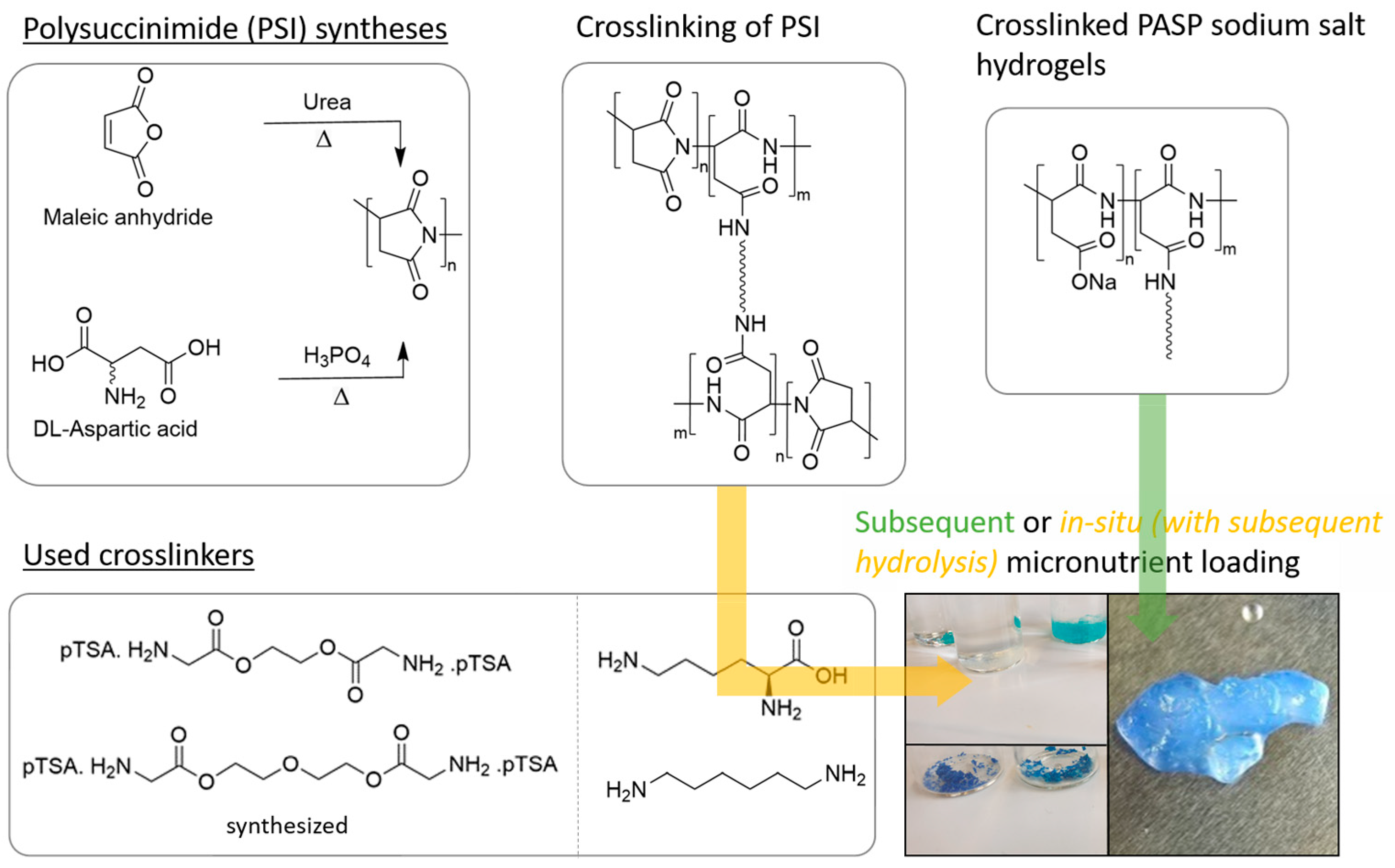

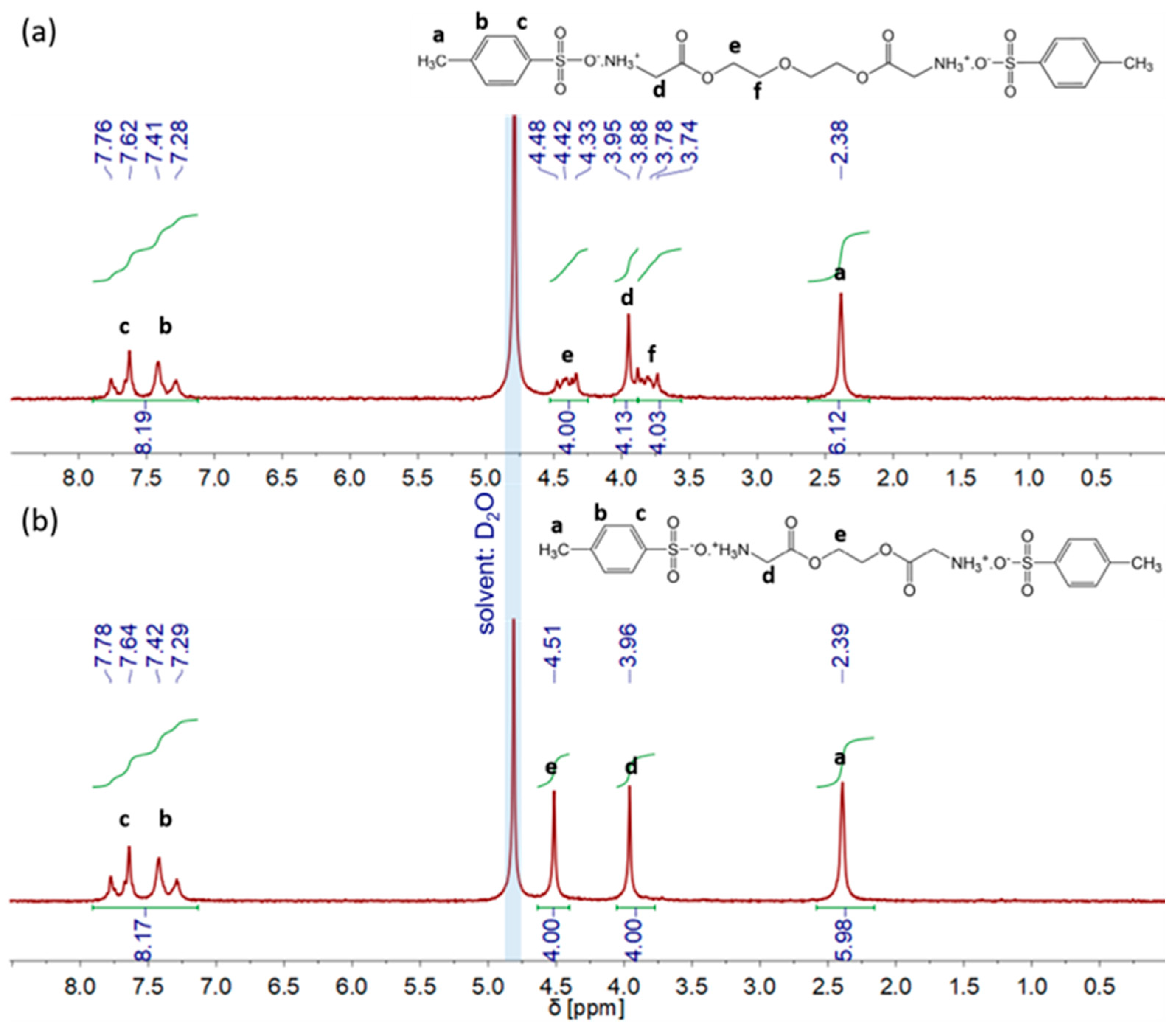
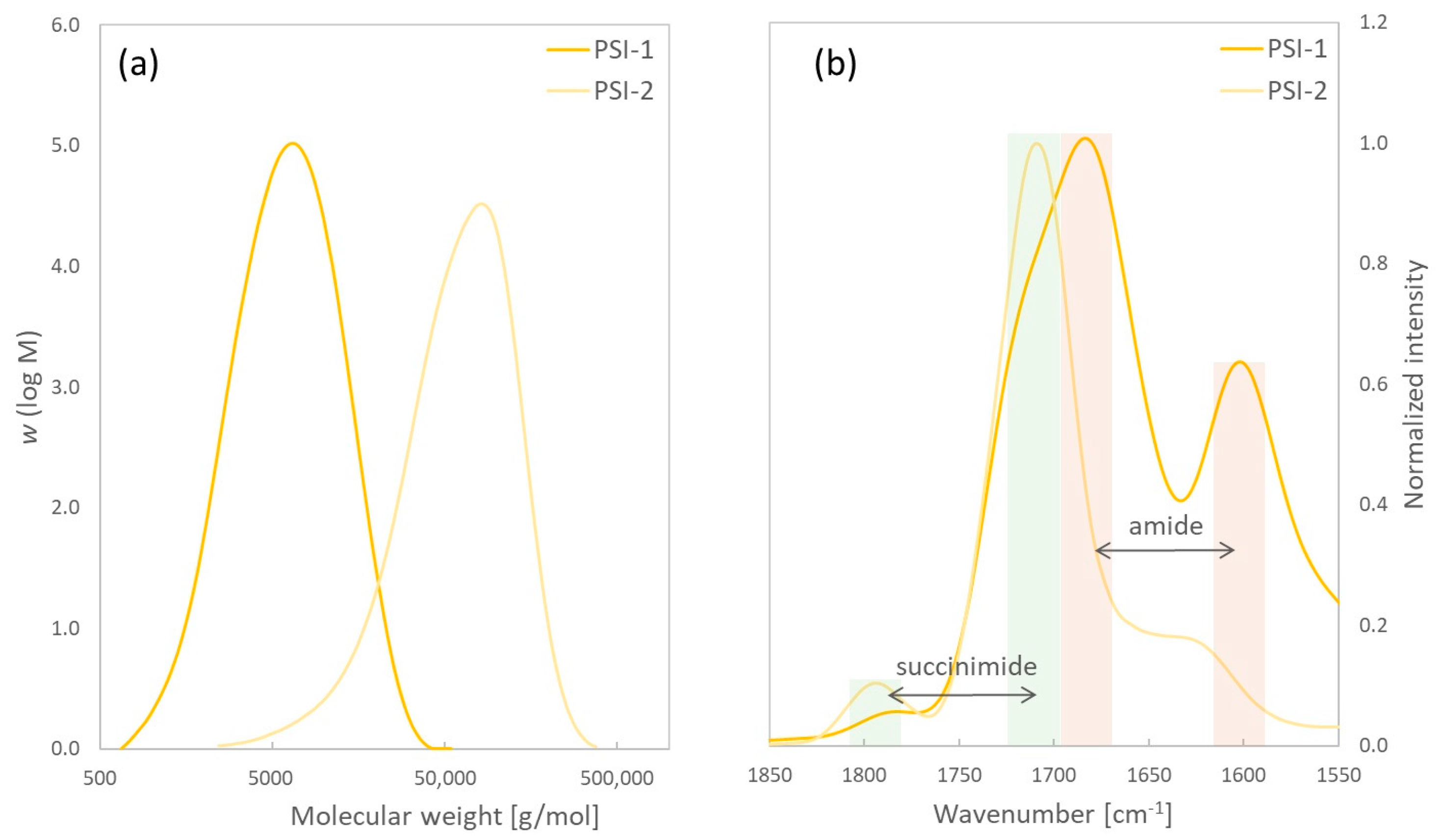
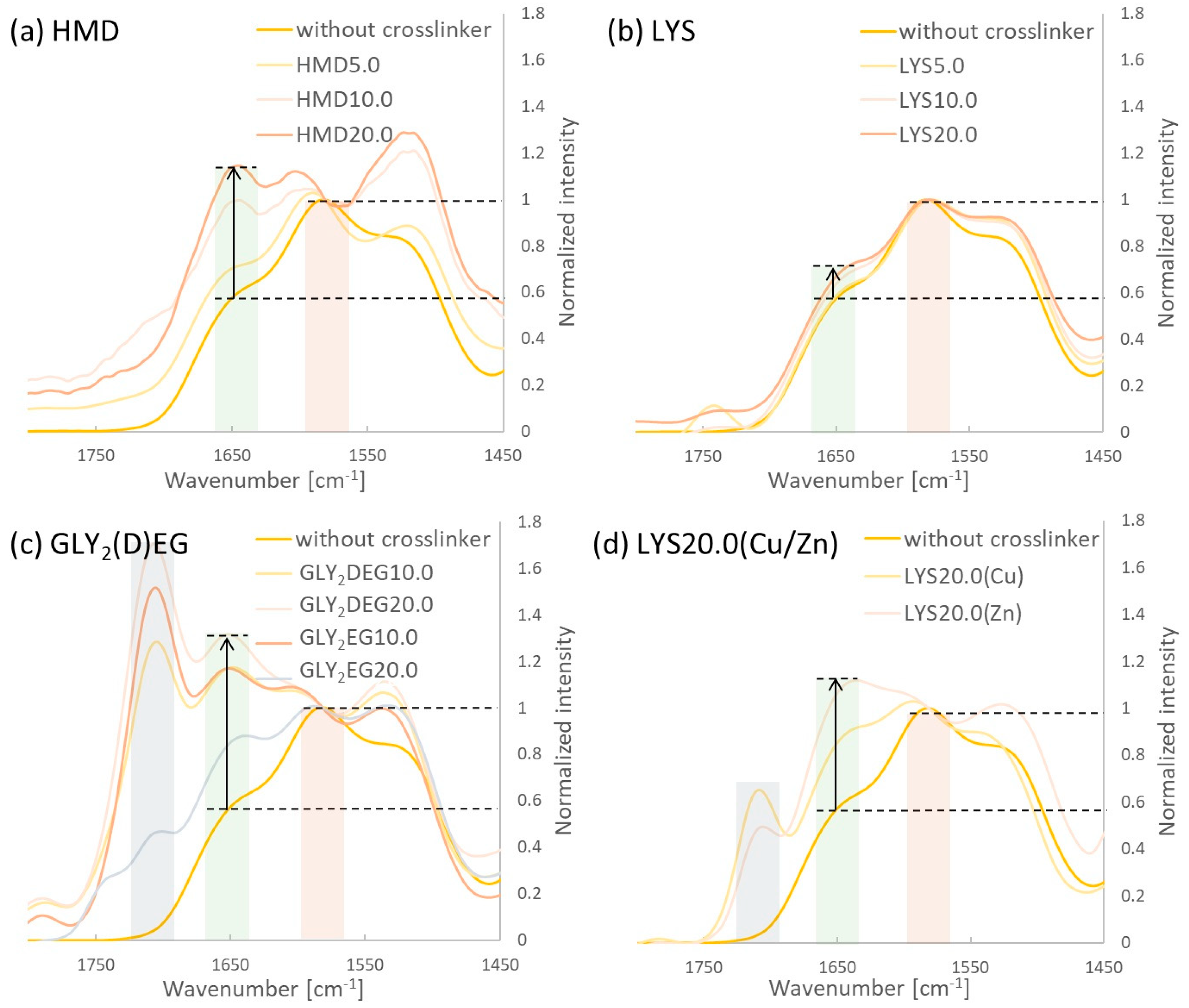
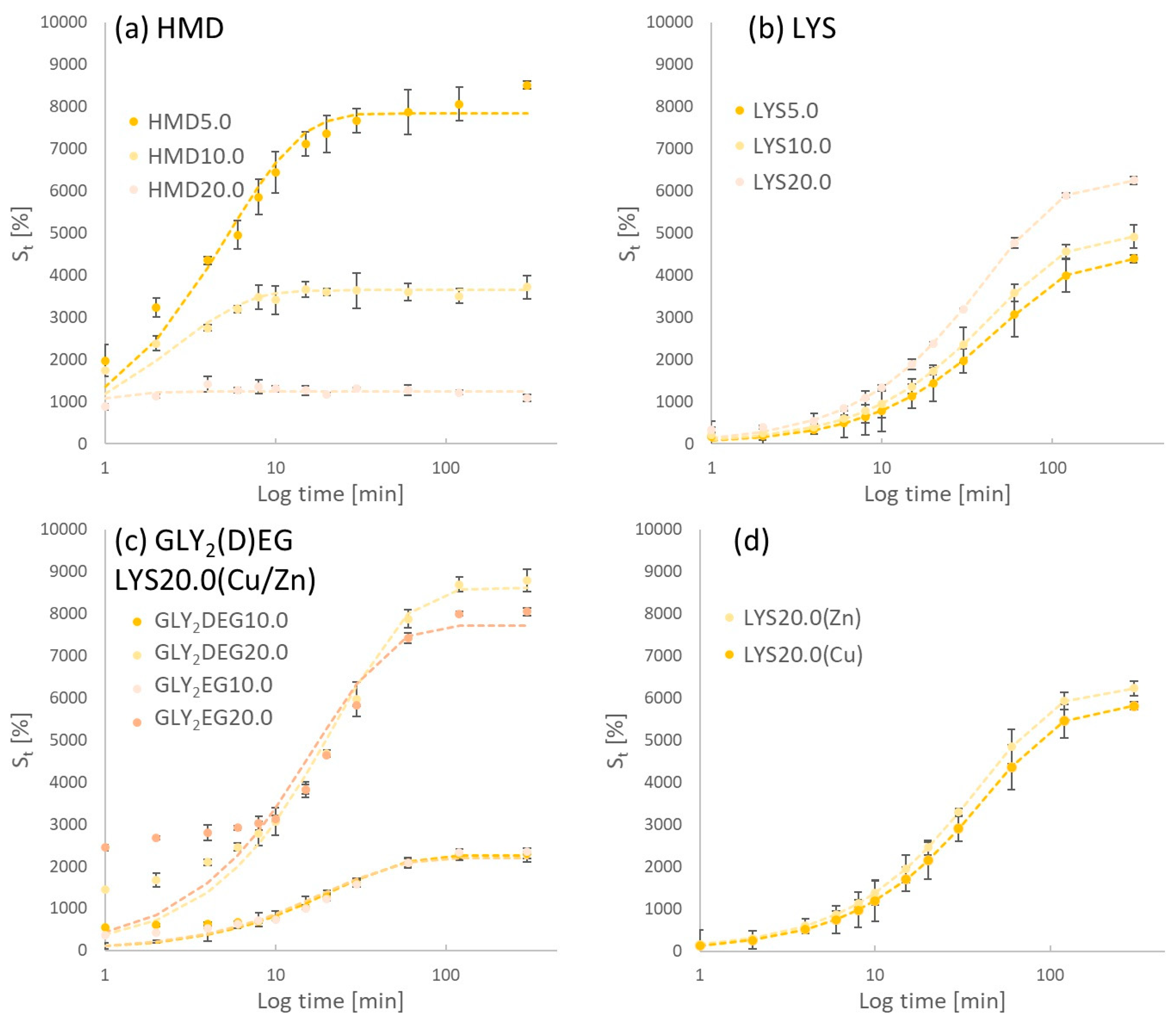
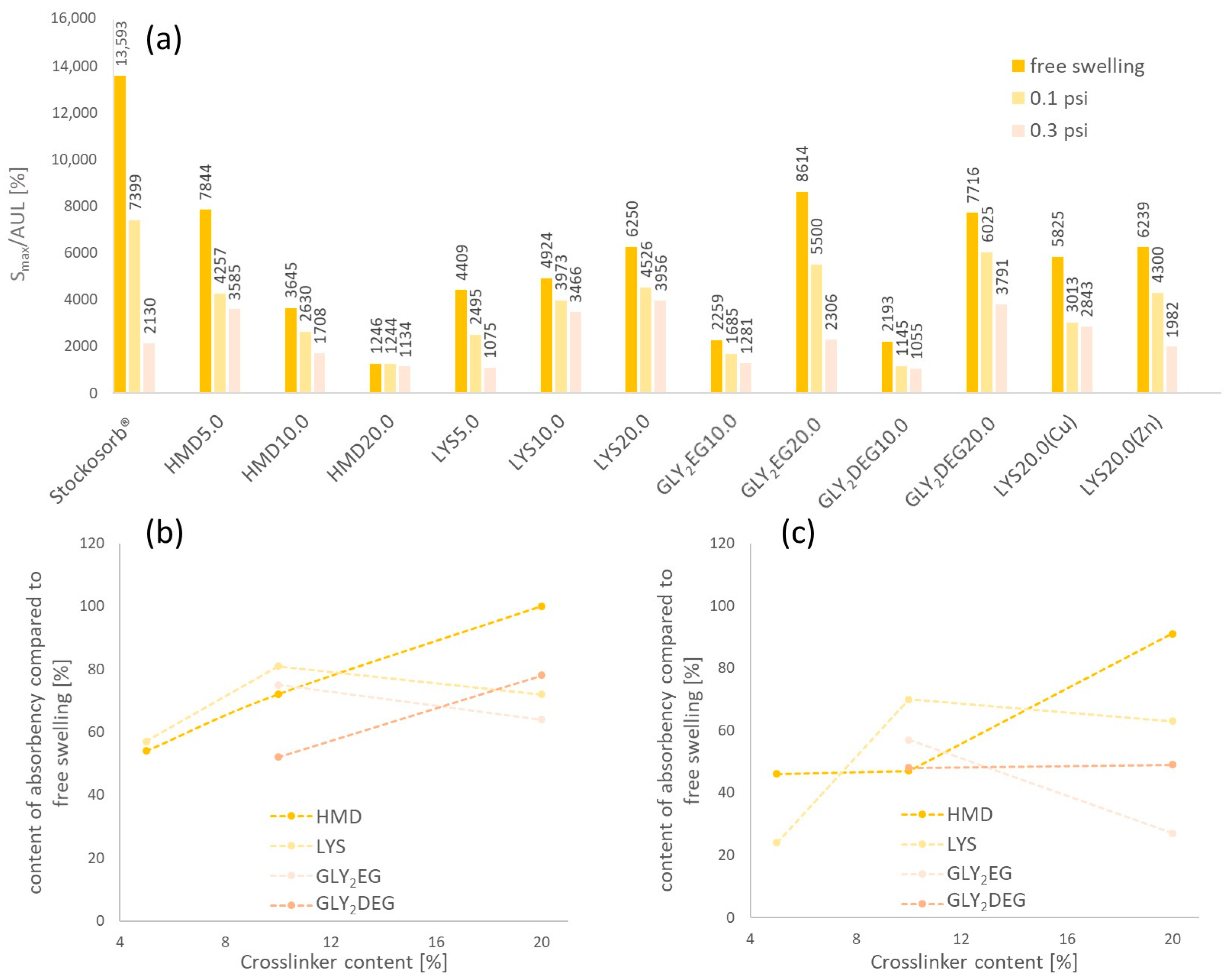


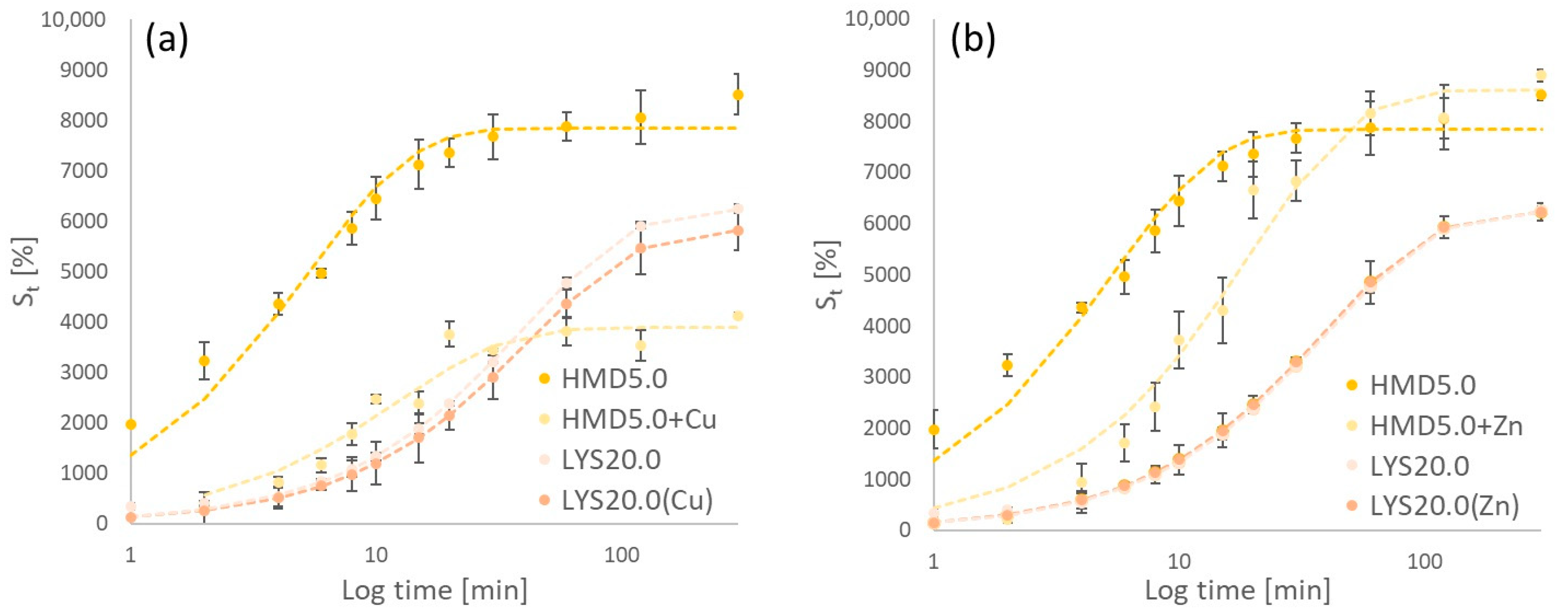
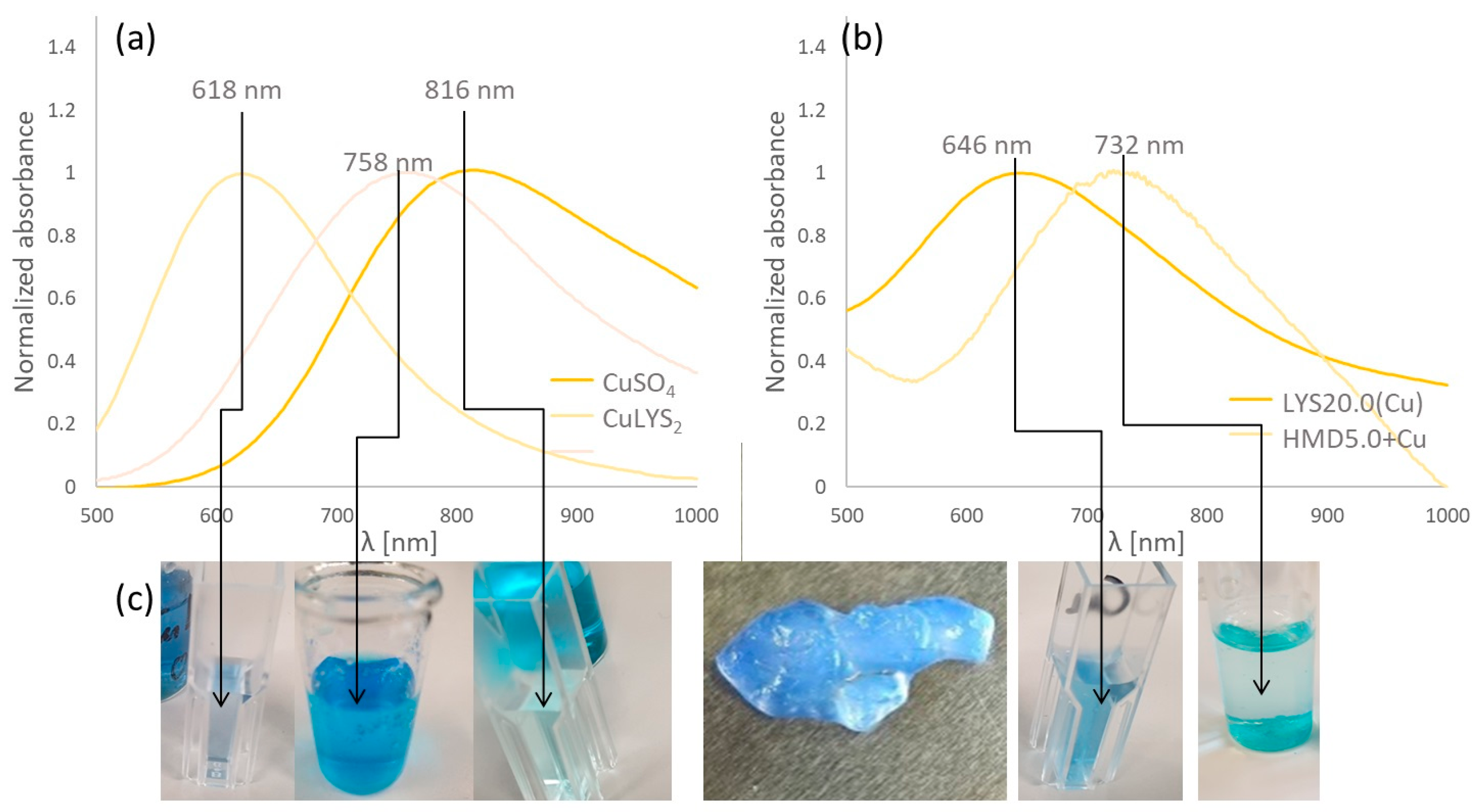
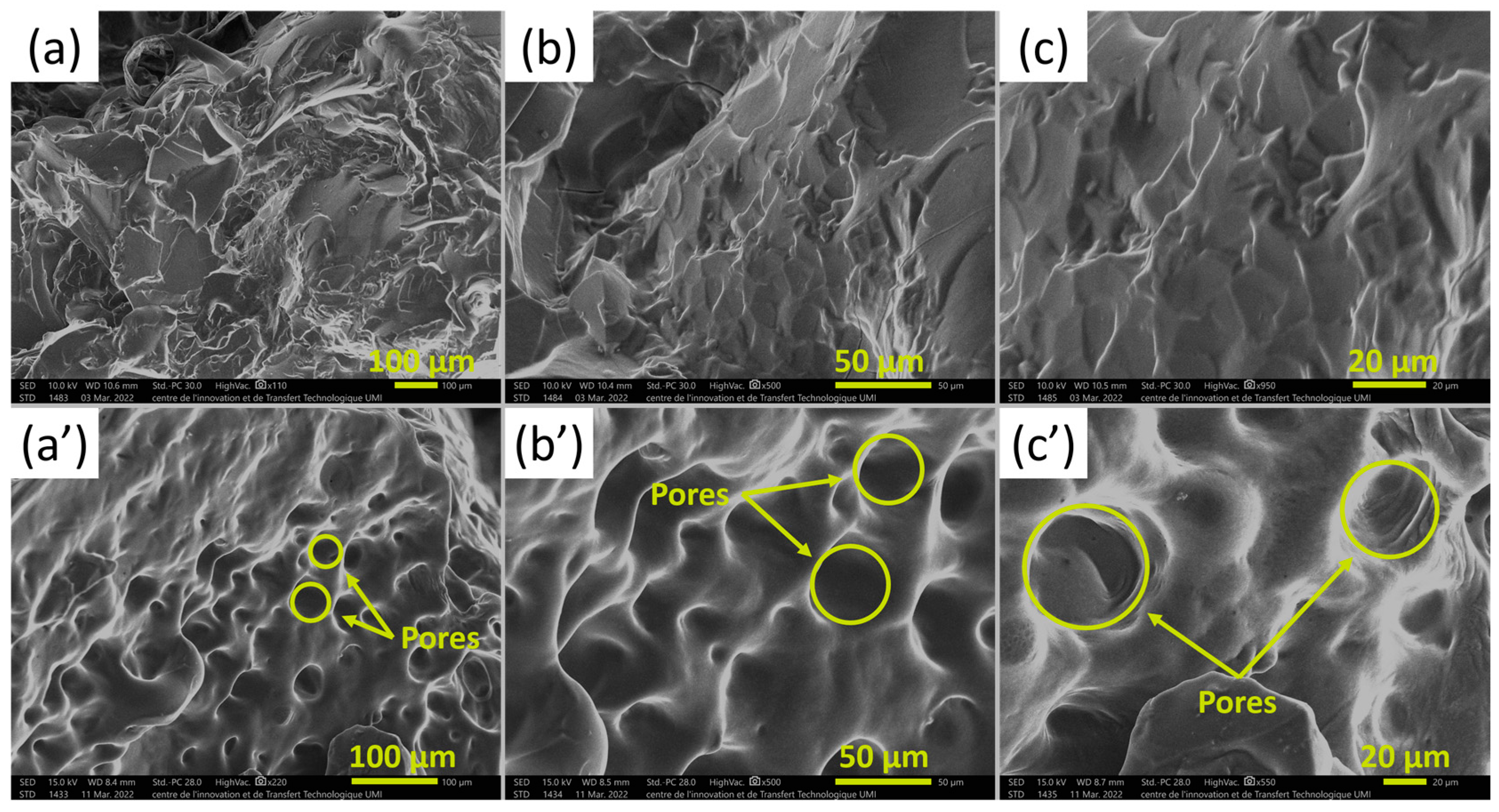

| Sample | Reaction Method/ Monomers | Acid(s) | Ratio (Monomer(s)/Acid(s)) [mol:mol] | Yield [g] (%) | Mn [g/mol] (PDI) | Reaction Time [min] |
|---|---|---|---|---|---|---|
| PSI-1 | MA + urea | H3PO4 + H2SO4 | 4:1 | 7.92 (89) | 4850 (1.63) | 180 |
| PSI-2 | ASP | H3PO4 | 2:1 | 8.64 (95) | 41,700 (1.75) |
| Sample Name * | Used Crosslinker | Amounts of Crosslinker [%] |
|---|---|---|
| clPASP-HMD5.0 | 1,6-hexamethylenediamine | 5.0 |
| clPASP-HMD10.0 | 10.0 | |
| clPASP-HMD20.0 | 20.0 | |
| clPASP-LYS5.0 | L-lysine | 5.0 |
| clPASP-LYS10.0 | 10.0 | |
| clPASP-LYS20.0 | 20.0 | |
| clPASP-GLY2DEG10.0 | bis-(glycine)-diethylene glycol ester | 10.0 |
| clPASP-GLY2DEG20.0 | 20.0 | |
| clPASP-GLY2EG10.0 | bis-(glycine)-ethylene glycol ester | 10.0 |
| clPASP-GLY2EG20.0 | 20.0 | |
| clPASP-LYS20.0(Cu) | L-lysine | 20.0 |
| clPASP-LYS20.0(Zn) | 20.0 |
| Sample Name | Smax | t63 |
|---|---|---|
| HMD5.0 | 7844 | 5.27 |
| HMD10.0 | 3645 | 2.56 |
| HMD20.0 | 1246 | 0.50 |
| LYS5.0 | 4409 | 50.44 |
| LYS10.0 | 4924 | 46.19 |
| LYS20.0 | 6250 | 41.64 |
| GLY2DEG10.0 | 2259 | 22.00 |
| GLY2DEG20.0 | 8614 | 22.80 |
| GLY2EG10.0 | 2193 | 19.79 |
| GLY2EG20.0 | 7716 | 17.28 |
| LYS20.0(Cu) | 5825 | 43.45 |
| LYS20.0(Zn) | 6239 | 39.97 |
| Stockosorb® | 19,282 | 6.47 |
| Sample Name | c (Cu/Zn Solution) [mol/L] |
|---|---|
| HMD20.0/10.0/5.0 + Zn0.100 | 0.100 |
| HMD20.0/10.0/5.0 + Cu0.100 | |
| PASP + Zn0.100 | |
| PASP + Cu0.100 | |
| HMD20.0/10.0/5.0 + Zn0.050 | 0.050 |
| HMD20.0/10.0/5.0 + Cu0.050 | |
| PASP + Zn0.050 | |
| PASP + Cu0.050 | |
| HMD20.0/10.0/5.0 + Zn0.025 | 0.025 |
| HMD20.0/10.0/5.0 + Cu0.025 | |
| PASP + Zn0.025 | |
| PASP + Cu0.025 | |
| HMD20.0/10.0/5.0 + Zn0.0125 | 0.0125 |
| HMD20.0/10.0/5.0 + Cu0.0125 | |
| PASP + Zn0.0125 | |
| PASP + Cu0.0125 |
| Sample Name | Smax | t63 |
|---|---|---|
| HMD5.0 | 7844 | 5.27 |
| HMD5.0 + Cu | 3891 | 12.59 |
| HMD5.0 + Zn | 8618 | 19.70 |
| LYS20.0 | 6250 | 41.64 |
| LYS20.0(Cu) | 5825 | 43.45 |
| LYS20.0(Zn) | 6239 | 39.97 |
| Sample Name | m (PSI) [g] | Crosslinker Content [mol-%] | m (HMD)/ 2.0 g of PSI [g] | Yield [g] |
|---|---|---|---|---|
| clPSI-HMD5.0 | 2.0 | 5.0 | 0.12 | 2.26 |
| clPSI-HMD10.0 | 10.0 | 0.24 | 2.52 | |
| clPSI-HMD20.0 | 20.0 | 0.48 | 2.30 |
| Sample Name | m (PSI) [g] | Crosslinker Content [%] | m (LYS)/ 2.0 g of PSI [g] | Yield [g] |
|---|---|---|---|---|
| clPSI-LYS5.0 | 2.0 | 5.0 | 0.15 | 0.92 |
| clPSI-LYS10.0 | 10.0 | 0.30 | 2.50 | |
| clPSI-LYS20.0 | 20.0 | 0.60 | 2.40 |
| Sample Name | m (PSI) [g] | Crosslinker Content [%] * | m (GLY2(D)EG)/2.0 g of PSI [g] | TEA [µL] |
|---|---|---|---|---|
| clPSI-GLY2DEG10.0 | 2.0 | 10.0 | 1.25 | 629 |
| clPSI-GLY2DEG20.0 | 20.0 | 2.50 | 1238 | |
| clPSI-GLY2EG10.0 | 10.0 | 1.16 | 629 | |
| clPSI-GLY2EG20.0 | 20.0 | 2.33 | 1238 |
| Sample Name | Used Mass of clPSI [g] | V (1.0 mol/L NaOH) per 1.0 g of clPSI [mL] | Yield [g] |
|---|---|---|---|
| HMD5.0 | 2.0 | 10 | 2.34 |
| HMD10.0 | 2.30 | ||
| HMD20.0 | 1.93 | ||
| LYS5.0 | 0.80 | ||
| LYS10.0 | 1.97 | ||
| LYS20.0 | 1.50 | ||
| GLY2DEG10.0 | 1.70 | ||
| GLY2DEG20.0 | 1.20 | ||
| GLY2EG10.0 | 1.36 | ||
| GLY2EG20.0 | 1.12 | ||
| LYS20.0(Cu) | 1.0 | 0.60 | |
| LYS20.0(Zn) | 0.70 |
Disclaimer/Publisher’s Note: The statements, opinions and data contained in all publications are solely those of the individual author(s) and contributor(s) and not of MDPI and/or the editor(s). MDPI and/or the editor(s) disclaim responsibility for any injury to people or property resulting from any ideas, methods, instructions or products referred to in the content. |
© 2024 by the authors. Licensee MDPI, Basel, Switzerland. This article is an open access article distributed under the terms and conditions of the Creative Commons Attribution (CC BY) license (https://creativecommons.org/licenses/by/4.0/).
Share and Cite
Hafidi, Y.; El Hatka, H.; Schmitz, D.; Krauss, M.; Pettrak, J.; Biel, M.; Ittobane, N. Sustainable Soil Additives for Water and Micronutrient Supply: Swelling and Chelating Properties of Polyaspartic Acid Hydrogels Utilizing Newly Developed Crosslinkers. Gels 2024, 10, 170. https://doi.org/10.3390/gels10030170
Hafidi Y, El Hatka H, Schmitz D, Krauss M, Pettrak J, Biel M, Ittobane N. Sustainable Soil Additives for Water and Micronutrient Supply: Swelling and Chelating Properties of Polyaspartic Acid Hydrogels Utilizing Newly Developed Crosslinkers. Gels. 2024; 10(3):170. https://doi.org/10.3390/gels10030170
Chicago/Turabian StyleHafidi, Youssef, Hicham El Hatka, Dominik Schmitz, Manuel Krauss, Jürgen Pettrak, Markus Biel, and Najim Ittobane. 2024. "Sustainable Soil Additives for Water and Micronutrient Supply: Swelling and Chelating Properties of Polyaspartic Acid Hydrogels Utilizing Newly Developed Crosslinkers" Gels 10, no. 3: 170. https://doi.org/10.3390/gels10030170
APA StyleHafidi, Y., El Hatka, H., Schmitz, D., Krauss, M., Pettrak, J., Biel, M., & Ittobane, N. (2024). Sustainable Soil Additives for Water and Micronutrient Supply: Swelling and Chelating Properties of Polyaspartic Acid Hydrogels Utilizing Newly Developed Crosslinkers. Gels, 10(3), 170. https://doi.org/10.3390/gels10030170








